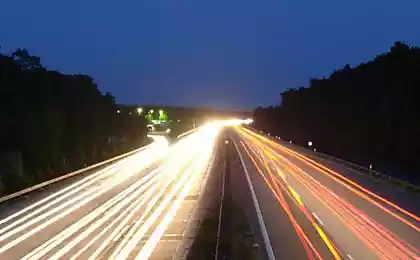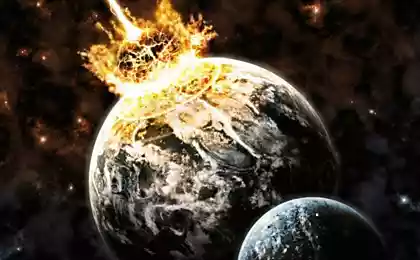706
The humanity will eat after the end of the world
Under dark skies ApokalipsisaKak avoid starvation, when suddenly there will be any apocalyptic event? How to feed 7 billion people on the planet? In trying to answer these questions by Joshua Pierce, an engineer from Michigan Technological University.

I think about these questions Pierce started back then, when I worked on a project for the delivery of low-cost drinking water to developing countries. It was then that Pierce realized that the consequences of global natural disasters can be scary.
«It set us in the time of dinosaurs, despite all our technological progress» , - he said.

Pierce and David Denkenberger, researcher at the Institute of global catastrophes, began to search for solutions to the problem of hunger, and found only one: it is necessary to store more food.
But this, according to researchers, will allow to feed the world's population in one year or less.
So they developed a number of other decisions which, in their view, would provide humanity with food for five years. Then they published a book entitled "Feed all, no matter what».
Below - Pierce answers some questions, and lists the most effective ways to survive a global catastrophe.
Which types of disasters you think in the first place?
Let's take the most likely: a nuclear winter. For example, two countries with nuclear weapons firmly angry at each other, and most of the major cities in both countries have been destroyed. In this case, the majority of mankind still survive. Let's say we have lost only 5% of the population. The remaining 95% are still alive. But as the destroyed cities burned, it will lead to the fact that we get a huge amount of soot in the upper atmosphere, because of which the planet would be much darker.
When the sky darkens, there will only be very resistant shrubs, trees, too, will live for some time. But what will happen to our conventional crops? With rice, wheat?
They will die. We can not get the crop, because it does not grow in the dark.
Since the crop is not, we are very hungry and start spending our food supplies. It was during this period will begin mass madness. And that's bad. I'm sure you've watched these movies, and at the end of each of them is not good. Darkness will keep for about five years, until, finally, will not go out of the atmosphere with the rain. Only then we will be able to restore agriculture.
In the above conditions will be able to survive only a tiny part of the agriculture - buildings, greenhouses, for example. In the same in Japan, for example, has a store in which the entire rack takes lettuce growing under the light of the LED lamps. And all of this would work even in the cataclysm, that's just what part of the population would be able to eat it? Perhaps it will have only the richest, for the rest, all these fruits and vegetables are simply not available.

So what do we have after the sky darkens?
There are many edible things that we usually do not consider as a meal. One of these things - leaves. They can be eaten. Only need to watch closely how you do it. The leaves of high fiber content, we will be able to digest and approximately half of these fibers. However, if you chew the leaves, but spits out the fibers, then so will be able to draw nutrients. Or, you can make tea of them.
Tea, by the way, the easiest to prepare.
The tea from pine needles of vitamin C contained more than 100 percent orange juice. In fact, you can easily make a tea from pine needles in his yard and get your daily dose of vitamin C.
Another type of food - insects.
Conversion ratio between food and biomass of insects is much higher than in cows. Beef production, the way we do it - is very inefficient. People, especially in the West used to turn up his nose against insects. But in the world there are many people who eat insects right now, so that when it comes to how to feed everyone, this is the most obvious solution.
This does not mean that you have to eat them raw. You hardly notice the difference between, say, with the usual sausage patty, sausage patty with a vegetarian, pies and insects. It's almost the same thing. And much depends on spice.
Oceans can feed us?
If you look at the number of fish that we eat now, the fish - a tiny part of our diet. If there is a serious climate change, which has led to significant upwelling (ie the upsurge in deep ocean water to the surface), it will be similar to the fertilization of the ocean surface, which will result in more fish. But this process we can spend ourselves, with the same purpose. And we had a sufficient number of fish to feed everyone. But how to catch it all?
Then we began to study how many ships there, and what would happen if all of them turn to fishing ships. It turned out that everything depends on the distance that the fishing vessel goes to a place of catch and return. Do not get to have a lot of fishing schooners that go into the sea to catch fish there, and then returned to the fish back to port. The solution to this problem - the transfer of fish from vessel to vessel, which, fortunately, is practiced today. Thus, the rate of fish may be the best solution in certain circumstances.
You have suggested that we may have bacteria. How does it work?
There are two main sources of bacteria for which we have paid attention. There the bacteria digesting methane, which can grow at the expense of natural gas. Then we can eat them directly, or process, or, say, to fatten them rats, and then eat the rats.
There is still a bacterium that can grow on wood. Or in any kind of mushroom waste. And then there are the bacteria that accumulate sugar, which they then eat. You can get this sugar by eating them. A portion of these bacteria can be added in a partially decayed wood. But what happens, you can feed someone else. All the same rat, for example, are capable of partially digesting wood, especially if it was prepared to have the above method. And it may be a good solution.

Have you experienced any of these decisions for yourself?
Of course. Much has been done just to see for myself that the taste - not too bad. The same pine tea is very good. Many insects, too bad, and I even go further and say - they are delicious.
In your book, you once mentioned that need a lot of chain saws. Why there should be a lot?
All the trees because of the lack of light will be dead. Therefore it has to significantly increase the rate of deforestation. Furthermore, the temperature will fall. We looked at a ten and twenty degrees scenario. When dvadtsatigradusnom scenario, you encounter the fact that all wood is the frozen. And this is a problem. If you want to use wood for breeding fungi or bacteria, then do it on the frozen wood it will be impossible. That is why it is so important to global cooperation. Then you can adjust the supply of timber from the equator. We are probably the first who tried to calculate how much of chain saws in the world, as they can run up to full deterioration, and how quickly we will be able to produce a new blade.
What is the most surprising thing you found?
It turns out that there are several solutions to support people around the globe. This primarily fossil fuels and wood. But the surprising thing is that even now, when we have everything in order to agriculture and not anything strange happening with our climate, we still can not feed everyone. Young children are still dying of hunger every day. And yet, now I know that we may well feed them at least a wood pulp. It was incredibly surprising.
via factroom.ru

I think about these questions Pierce started back then, when I worked on a project for the delivery of low-cost drinking water to developing countries. It was then that Pierce realized that the consequences of global natural disasters can be scary.
«It set us in the time of dinosaurs, despite all our technological progress» , - he said.

Pierce and David Denkenberger, researcher at the Institute of global catastrophes, began to search for solutions to the problem of hunger, and found only one: it is necessary to store more food.
But this, according to researchers, will allow to feed the world's population in one year or less.
So they developed a number of other decisions which, in their view, would provide humanity with food for five years. Then they published a book entitled "Feed all, no matter what».
Below - Pierce answers some questions, and lists the most effective ways to survive a global catastrophe.
Which types of disasters you think in the first place?
Let's take the most likely: a nuclear winter. For example, two countries with nuclear weapons firmly angry at each other, and most of the major cities in both countries have been destroyed. In this case, the majority of mankind still survive. Let's say we have lost only 5% of the population. The remaining 95% are still alive. But as the destroyed cities burned, it will lead to the fact that we get a huge amount of soot in the upper atmosphere, because of which the planet would be much darker.
When the sky darkens, there will only be very resistant shrubs, trees, too, will live for some time. But what will happen to our conventional crops? With rice, wheat?
They will die. We can not get the crop, because it does not grow in the dark.
Since the crop is not, we are very hungry and start spending our food supplies. It was during this period will begin mass madness. And that's bad. I'm sure you've watched these movies, and at the end of each of them is not good. Darkness will keep for about five years, until, finally, will not go out of the atmosphere with the rain. Only then we will be able to restore agriculture.
In the above conditions will be able to survive only a tiny part of the agriculture - buildings, greenhouses, for example. In the same in Japan, for example, has a store in which the entire rack takes lettuce growing under the light of the LED lamps. And all of this would work even in the cataclysm, that's just what part of the population would be able to eat it? Perhaps it will have only the richest, for the rest, all these fruits and vegetables are simply not available.

So what do we have after the sky darkens?
There are many edible things that we usually do not consider as a meal. One of these things - leaves. They can be eaten. Only need to watch closely how you do it. The leaves of high fiber content, we will be able to digest and approximately half of these fibers. However, if you chew the leaves, but spits out the fibers, then so will be able to draw nutrients. Or, you can make tea of them.
Tea, by the way, the easiest to prepare.
The tea from pine needles of vitamin C contained more than 100 percent orange juice. In fact, you can easily make a tea from pine needles in his yard and get your daily dose of vitamin C.
Another type of food - insects.
Conversion ratio between food and biomass of insects is much higher than in cows. Beef production, the way we do it - is very inefficient. People, especially in the West used to turn up his nose against insects. But in the world there are many people who eat insects right now, so that when it comes to how to feed everyone, this is the most obvious solution.
This does not mean that you have to eat them raw. You hardly notice the difference between, say, with the usual sausage patty, sausage patty with a vegetarian, pies and insects. It's almost the same thing. And much depends on spice.
Oceans can feed us?
If you look at the number of fish that we eat now, the fish - a tiny part of our diet. If there is a serious climate change, which has led to significant upwelling (ie the upsurge in deep ocean water to the surface), it will be similar to the fertilization of the ocean surface, which will result in more fish. But this process we can spend ourselves, with the same purpose. And we had a sufficient number of fish to feed everyone. But how to catch it all?
Then we began to study how many ships there, and what would happen if all of them turn to fishing ships. It turned out that everything depends on the distance that the fishing vessel goes to a place of catch and return. Do not get to have a lot of fishing schooners that go into the sea to catch fish there, and then returned to the fish back to port. The solution to this problem - the transfer of fish from vessel to vessel, which, fortunately, is practiced today. Thus, the rate of fish may be the best solution in certain circumstances.
You have suggested that we may have bacteria. How does it work?
There are two main sources of bacteria for which we have paid attention. There the bacteria digesting methane, which can grow at the expense of natural gas. Then we can eat them directly, or process, or, say, to fatten them rats, and then eat the rats.
There is still a bacterium that can grow on wood. Or in any kind of mushroom waste. And then there are the bacteria that accumulate sugar, which they then eat. You can get this sugar by eating them. A portion of these bacteria can be added in a partially decayed wood. But what happens, you can feed someone else. All the same rat, for example, are capable of partially digesting wood, especially if it was prepared to have the above method. And it may be a good solution.

Have you experienced any of these decisions for yourself?
Of course. Much has been done just to see for myself that the taste - not too bad. The same pine tea is very good. Many insects, too bad, and I even go further and say - they are delicious.
In your book, you once mentioned that need a lot of chain saws. Why there should be a lot?
All the trees because of the lack of light will be dead. Therefore it has to significantly increase the rate of deforestation. Furthermore, the temperature will fall. We looked at a ten and twenty degrees scenario. When dvadtsatigradusnom scenario, you encounter the fact that all wood is the frozen. And this is a problem. If you want to use wood for breeding fungi or bacteria, then do it on the frozen wood it will be impossible. That is why it is so important to global cooperation. Then you can adjust the supply of timber from the equator. We are probably the first who tried to calculate how much of chain saws in the world, as they can run up to full deterioration, and how quickly we will be able to produce a new blade.
What is the most surprising thing you found?
It turns out that there are several solutions to support people around the globe. This primarily fossil fuels and wood. But the surprising thing is that even now, when we have everything in order to agriculture and not anything strange happening with our climate, we still can not feed everyone. Young children are still dying of hunger every day. And yet, now I know that we may well feed them at least a wood pulp. It was incredibly surprising.
via factroom.ru























